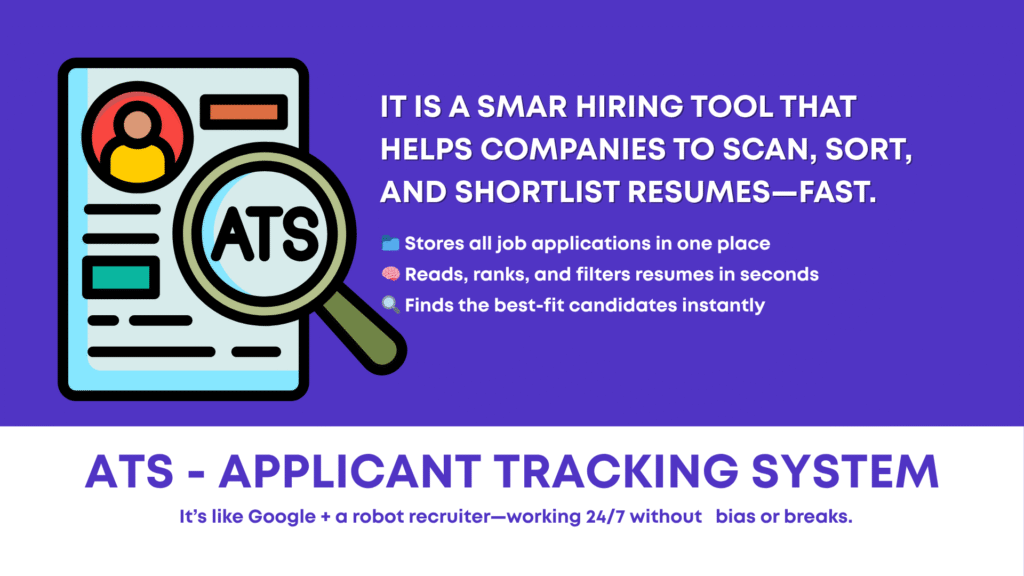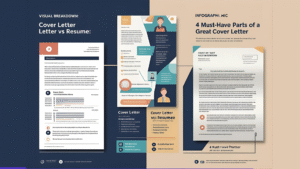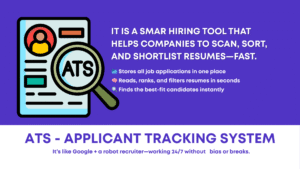Imagine you’re a school teacher, and 500 students submit their homework at once. Reading each one manually would take a lot of time. Is it possible for you to read them all in a short time? No, it’s impossible.
Now, picture a smart robot that scans every paper in seconds, sorts and ranks them, and tells you which ones are the best. Sounds like magic?
Well, that’s exactly what an ATS does—but for job applications.
So, What Exactly Is an ATS?

ATS stands for Applicant Tracking System.
It’s like a super-smart digital helper that companies use when they need to hire new employees.
Think of it like this:
🗂️ A digital filing cabinet that keeps all resumes in one safe place.
🧠 A smart brain that reads and understands resumes super-fast.
🔍 A search engine (like Google!) that finds the best candidates in seconds.
Instead of piles of messy papers, everything is neatly organized on a computer screen. No chaos. No confusion.
Think of an ATS like a super-smart robot assistant that works 24/7 without sleep. Companies use it whenever they need to hire new employees.
Why do they use it? Because big companies receive hundreds — sometimes thousands — of resumes for a single job post. Even smaller companies get more than they can handle.
Now imagine if a person had to read every single resume, line by line. It would take days or even weeks! That’s why companies use ATS. It makes the hiring process faster, easier, and more organized.
If you apply for a job today, your first reader isn’t a human — it’s the ATS. It’s not good or bad. It’s just doing its job: scanning a mountain of resumes to find the most relevant ones for the role.
But remember, the ATS doesn’t make the final decision. It simply decides which resumes move forward. It helps companies save time, stay organized, and find the right candidates more efficiently.
How Does an ATS Actually Work? (Step-by-Step Guide Like a Story):
In simple terms, an ATS automatically collects, scans, sorts, and ranks job applications. It acts as a digital gatekeeper between you and the recruiter.
But it’s not as simple as it sounds — behind the scenes, it works like a complex digital brain, processing each application through multiple steps with speed and precision.
Let’s pull back the curtain and see how it really works — a powerful system that helps companies manage hundreds (even thousands!) of applications in a short time.
Now, let’s break it down into 7 simple steps — including some hidden secrets most job seekers don’t know.
Step 1: Job Posting:
Once a company decides to hire, the recruiter types the full job description into the ATS — including required skills, experience, locations, salary range, etc.
But here’s the secret: This is where the ATS starts building its rulebook. Every word written in that job post becomes part of a checklist for scanning future resumes.
Then the ATS doesn’t just stop there — it acts like a powerful publisher. It automatically shares the job across:
- The company’s own website
- Job boards (like Indeed, Naukri, JobRath, Monster)
- Social media (LinkedIn, Facebook, etc.)
- Even internal employee referrals
Why it matters: The more places the job appears, the more applicants apply. But remember — the ATS is already preparing to filter them all.
Step 2: Applications Roll In — and the ATS Collects Everything into One Clean, Organized Dashboard:
Now, hundreds of candidates apply from different sources. Some apply from a job board. Others from an email link. Some are employee referrals.
No matter where they come from, the ATS gathers them all and organizes everything neatly into one central digital dashboard. Each applicant gets their own digital folder — complete with their resume, contact details, and real-time status updates.
Why it matters: It helps recruiters stay perfectly organized — even if 5,000 people apply for the same job. No resume gets lost in email threads. No document is misplaced. Everything is safe, searchable, and sorted.
Step 3: Resume Parsing
This is where the ATS gets really smart.
As soon as your resume enters the system, the ATS starts “reading” it — not like a human, but like a robot built to detect patterns and keywords at lightning speed.
The ATS scans your resume for things like:
- Keywords from the job description
- Skills and software knowledge
- Previous job titles
- Length of work experience
- Education and certifications
- Location and availability
- Your contact information
Even if your resume is colourful or creatively designed, the ATS breaks it into simple, readable chunks it can understand. This process is called “resume parsing”, and it happens in milliseconds.
The parsed information is stored in the system and used to compare your resume with other candidates.
But here’s the catch: If your resume doesn’t include the right keywords or proper structure that match the job posting, the ATS might think you’re not a good fit — and silently reject your resume, even if you’re actually qualified.
Step 4: Resume Screening - How the ATS Ranks Your Resume:
Once the scanning is done, the ATS compares your resume to the job description. It looks for specific keywords, skills, and qualifications that match what the company is looking for.
If your resume includes the right terms, the ATS gives it a score — based on how closely it matches the job posting. You might get a rating like 80%, 65%, or 40% match.
The closer your resume matches the job requirements, the higher your score.
Think of it like this:
Strong match = Top of the list
Medium match = Maybe pile
Poor match = Bottom or ignored
Then the ATS sorts all the resumes into categories:
Best matches go to the top
Average matches stay in the middle
Low matches drop to the bottom — or may be filtered out completely
The top-scoring resumes float to the top — these are the first ones that recruiters actually see.
This system helps recruiters save time. Instead of reading 500 resumes one by one, they get a ranked list of top candidates in seconds.
💡 Secret Insight: Some ATS tools even use colour codes — like green for good matches, yellow for average, and red for poor — to make the process even faster.
Step 5: Filtering & Shortlisting — How Recruiters Pick the Best Fit:
Once resumes are scanned and ranked, it’s time for filters and shortlisting.
Now, recruiters apply filters to quickly narrow down the list. For example, they may look for:
- Candidates with 3+ years of experience
- Specific degrees or certifications
- Applicants from a particular location
- Experience with certain tools or software
- Full-time availability
These filters help recruiters zoom in on the most relevant candidates without wasting time. It lets them focus only on the profiles that closely match what the company is actually looking for.
The ATS also handles routine admin tasks like:
- Sending confirmation emails
- Scheduling interviews
- Moving candidates to the next hiring stage
This means recruiters don’t have to spend time on repetitive work. Instead, they can focus on choosing the best candidates.
The ATS instantly shows only the resumes that meet the filter criteria — making it super easy to shortlist the top matches.
Step 6: Real-Time Communication & Status Tracking — Ensuring Smooth Coordination Without Missing Any Candidate:
Once the top candidates are shortlisted, the ATS helps recruiters easily view the highest-ranked resumes. They go through this shortlist and decide whom to contact for interviews.
The ATS also tracks every step of the hiring process in real time, so nothing gets missed.
For example, it tracks:
- Who received a confirmation email
- Who was contacted for an interview
- Who is scheduled for the next round
- What stage each candidate is in: Applied → Interview → Offer
- Recruiter notes and shared comments
- Who has been selected or rejected
Everything is recorded automatically, so no candidate slips through the cracks, and there’s no confusion about who is at which stage of the process.
The ATS also supports real-time communication between:
- Recruiters
- Hiring managers
- Candidates
This keeps the entire team in sync and ensures that candidates get timely updates.
Why it matters:
No one gets missed. Everyone stays informed. And the hiring process runs smoothly — without messy email threads or forgotten follow-ups.
Step 7: The ATS Provides Actionable Insights to Help Make Smarter Hiring Decisions:
After the interviews and evaluations, the ATS doesn’t just stop at tracking candidates — it also analyzes valuable data to help companies make better, faster, and more informed hiring decisions.
It generates detailed reports and insights such as:
- How many people applied for the job
- How long it takes to hire someone (time-to-hire)
- How much time is spent at each hiring stage
- Which job sites bring the best-quality candidates
- Where candidates drop off (like a bad page on a website)
- Why certain candidates were shortlisted or rejected
- Which roles are hardest to fill — and where applicants are dropping off
- How well each recruiter is performing
- Which cities or regions have the strongest talent
- Where top candidates are coming from (LinkedIn? Referrals? Career site?)
- How fast recruiters are working and responding
These insights help hiring teams clearly understand what’s working well — and what needs to be improved in the recruitment process.
For example:
- If most top candidates come from one job board, recruiters can prioritize it next time.
- If too many resumes are being rejected early, they can review the job description or keyword filters.
- If hiring takes too long, the team can streamline or automate certain steps.
Why it matters:
These data-driven insights help companies hire smarter, faster, and more fairly. Even hiring managers are learning and improving every day — and it’s the ATS data that guides those improvements.
Are You Ready to Beat the ATS and Land Interviews Faster?
Don’t let a resume mismatch block your dream job.
Let JobRath help you get noticed — not ignored.
✅ Get matched to the right jobs
✅ Receive personalized job alerts
✅ Boost your resume’s ATS score
✅ Learn insider tips to crack interviews
🎯 Start your success journey now — it’s 100% free!
👉 Register Now –
Supercharge Your Career with Expert Tips
Subscribe on YouTube for job updates, resume hacks, and real interview guidance:
🔗 youtube.com/@JobsRath
Stay Ahead. Stay Informed. Stay Connected.
Follow us for instant job alerts and career growth content:
👉 Facebook | Instagram | LinkedIn
About Author
Mohd Tauheed
I am a seasoned content and advertising professional with 8+ years of proven experience in content creation, digital marketing, and SOP writing. My background spans both healthcare and consumer domains, where I have developed impactful promotional content, SEO-optimized articles, ad copy, and campaign strategies across print, digital, and social media platforms. I bring a strong command over English and Hindi writing, hands-on experience with Facebook Ads, Google Ads, and meta analytics tools, and a record of managing content for diverse industries including healthcare, education, IT, and interiors.
Explore More Recent Posts

What Is US Healthcare Training – And Why It’s the #1 Career Game-Changer for Indian Jobseekers in 2025?
Are you stuck in a low-paying BPO job—or unsure where your degree is taking you? U.S. Healthcare Training empowers Indian graduates to launch high-paying international careers—right from India. In just 3 months, learn Medical Billing, AR Calling, and Denial Management. No medical degree required. Get job-ready for top healthcare BPO roles in Noida, Pune, and beyond.
Start your breakthrough today—your career upgrade begins here.

What Is a Cover Letter? 7 Reasons Why It Matters More Than You Realize (And How to Write One That Actually Works)
A cover letter is not just a formality—it’s your best shot at showing who you really are beyond bullet points. While your resume says what you’ve done, a great cover letter tells why it matters—and why you’re the right person for the job.

What is an ATS? (And Why It’s So Important for Job Seekers!)
An ATS is a smart computer program that helps companies hire people. It collects all the resumes, reads them quickly, and picks the best ones. If you’ve applied for a job, your resume probably went through an ATS before a person saw it. That’s why learning how ATS works can help you get noticed and get hired.

10 Things NOT to Do on Your CV (Avoid These Critical Resume Mistakes to Get Shortlisted Fast)
Not getting interview callbacks? You may be making invisible CV mistakes. Discover the hidden errors most professionals overlook and how to fix them for faster results. Read now to uncover the 10 Things NOT to Do on Your CV.

Why Your Resume Is Not Getting Shortlisted – Top Resume Mistakes and Proven Fixes That Get Results
Are you struggling to get interview calls? Your resume might be the real reason. Most job seekers make common resume mistakes that go unnoticed—and cost them big opportunities. In this eye-opening guide, we will uncover exactly why your resume is not working and explore proven, easy-to-implement strategies that help you get shortlisted faster.
Do not let your dream job slip away—click to read now!

